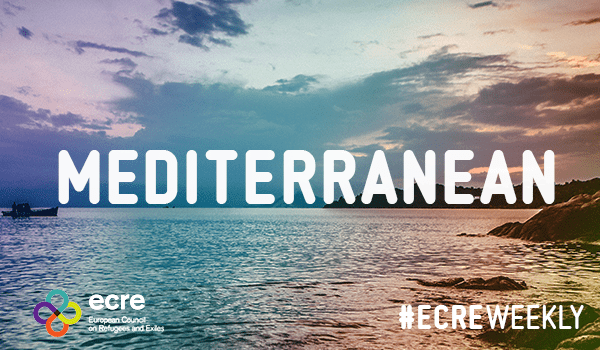As people are forced to take ever more dangerous routes, the tragedy on the Mediterranean continues. 2021 closed with a death toll of more than 1,500 lives lost over the year: meanwhile, more than 32,000 people were intercepted and returned to Libya where the situation deteriorates further.
Prevention and deterrence measures in Europe – most notably, systematic pushback operations by Greek authorities – have forced people in need of protection to take more dangerous alternatives to the Eastern Mediterranean route. According to statistics from Frontex, the EU border and coast guard agency, there were more than 65,000 “illegal” border crossings on the Central Mediterranean route to the EU in the first 11 months of 2021 – 89 per cent more than in 2020 and 380 per cent more than in 2019. Statistics from the agency further reveal that 2021 marked the highest number of deaths along irregular migration routes since 2017 with 3,029 confirmed fatalities. The vast majority of deaths occurred on the Atlantic route as well as the Western and Central Mediterranean routes. Statistics from the International Organization for Migration (IOM) find that 1,552 people died or went missing on the Central Mediterranean route in 2021 as of 25 December. Search and rescue blog the Civil Fleet states that: “1,100 people were rescued by civilian rescuers on three NGO ships in the central Mediterranean over the Christmas and New Year holidays”, while also underlining the continued lack of efficient action by European authorities keeping “Doctor’s Without Borders’ (MSF) Geo Barents, SOS Méditerranée‘s Ocean Viking, and Sea-Watch’s Sea-Watch 3 at sea for days after their crews had saved hundreds of lives. The NGO hotline Alarm Phone has reported 11 people missing since 31 December between Algeria and Italy.
More than 67,000 migrants disembarked in Italy in 2021, a significant increase from the 34,154 in 2020 but well below the record set in 2016 of 181,436. Lampedusa had 35,000 arrivals in 2021, more than half of Italy’s total. Arrivals to Italy continue in 2022 with 446 survivors rescued by Sea-Watch 3 on 2 January disembarking at the port of Pozzallo, in southern Sicily after more than a week at sea. On 4 January Seabird, a reconnaissance plane operated by Sea-Watch alerted the Banksy-funded Louise Michael rescue vessel to a boat with around 100 people in distress off an offshore gas platform operated by Shell on behalf of the Tunisian government. The crew of Louise Michel managed to rescue 31 people, who disembarked in Lampedusa on 6 January while around 70 others who climbed onto the platform were reportedly returned to Tunisia. On 16 December the Italian Court of Cassation – the highest court in the country, ruled in favor of two migrants who had been sentenced to three years and six months in jail and a fine of 52,000 euro for alleged aiding of illegal immigration, violence and aggravated resistance to a public official in 2018. The court held that it is allowed to resist orders to be taken back to Libya since the country cannot be considered safe.
Interceptions and returns to Libya close to tripled in 2021 compared to 2020. In a comment MSF warn that the more than 32,000 intercepted last year were : “brought back to systematic extortions, violence and abuse in Libya with the complicity of EU and EU member states”. The situation in Libya continues to deteriorate. Following major violent and deadly crackdowns by Libyan authorities in October 2021 with thousands of people detained, refugees and migrants have been demonstrating in front of the UN Refugee Agency (UNHCR) Community Day Center (CDC) in the capital of Tripoli. The protesters, supported by numerous NGOs, were demanding assistance and evacuations out of Libya. On 7 January the CDC facility was permanently closed, a move announced in December 2021. On 9-10 January Libyan security forces violently broke up a protest sit-in outside the centre and detained more than 600 people. “Witnesses have told us they were met with violence this morning and that makeshift tents were burnt down. This is the culmination of a disastrous situation that has deteriorated over the last few months,” said Dax Roque, the Norwegian Refugee Council’s Libya country director.
Last month, Libya named Mohammed al-Khoja, a militia leader implicated in abuses against migrants, as the new head of the Department for Combating Irregular Migration (DCIM). The DCIM is the body under the interior ministry which controls Libya’s infamous detention centres. Al-Khoja was previously the deputy head of DCIM and for years ran the Tarik al-Sikka centre in Tripoli, which is notorious for abuses including beatings, hard labour and a massive ransom scheme. He also has close ties to other, UN-sanctioned militia leaders and human traffickers in western Libya. The EU, which funds and equips the Libyan authorities, said it seeking clarification on al-Khoja’s appointment. “We think that it’s in the interest of Libya to have in important positions people who have a clean track record”. Last October, a UN-commissioned report said there was reasonable grounds to believe that abuse and ill treatment of migrants at sea, in centres and at the hands of traffickers amounts to crimes against humanity.
For further information:
- ECRE, Med: Pope Denounces EU Asylum Policies, Pre-removal Detention in Italy Deemed Unjustified, EU and Italy Increase Cooperation with Libya Amid Legal Action by NGOs, December 2021
- ECRE, Med: Dramatic Rescues as Weather Worsens, New Report on EU Funding and Complicity in Libyan Abuses, Libyan Political Instability Amplifies Risks for People on the Move, December 2021
Photo: ECRE
This article appeared in the ECRE Weekly Bulletin. You can subscribe to the Weekly Bulletin here.

